Allison Bruning's Blog, page 68
May 4, 2012
Inside the Secret World of Allison Bruning: A Whole New World
Inside the Secret World of Allison Bruning: A Whole New World: Little Acorns Publishing - The Acorn Has Sprung Ever feel that refreashing moment in your life when something completely changes and you a...
Published on May 04, 2012 04:26
A Whole New World
Little Acorns Publishing - The Acorn Has Sprung
Ever feel that refreashing moment in your life when something completely changes and you are soaring on the clouds like Aladdin and Jasmine in the Disney movie Aladdin? That is how I feel today. Recently I changed publishing houses to Little Acorns Publishing LTD. Little Acorns is a new publishing house located in Wales, United Kingdom that offers personalized services to their authors. Not only will they publish your ebook, print or both but they also offer help with marketing. Their team includes authors, editors, artists and a tech geek who understand the publishing world. This morning I am happy to introduce the founder of the company, Kristina Jackson, as she explains how her company was founded.

From where do these ideas spring? From random sleeting bouts of inspiration that fly through the universe. I made the decision to self-publish my books without the use of a publisher. Traditional or Indie. It was a decision purely based on personal reasons. I had no idea then I would be doing this now. Then one dream fell crashing around my ears. It was at this point, whilst I was sitting with the metaphorical debris around my ears, did this idea come.
Enter Tasha Turner, my friend, my confidante. She sat there in her hospital bed, having survived a car crash that would have finished many, helping me build on my concept. Using her skills and working with her ideas, I was in a position to offer a new and exciting approach to Indie Publishing. But what we needed was a team, including at least one author!
Here a chance conversation with another friend, Allison Bruning, came into play. I gave her an un-biased opinion of her options. I suggested to her she might try doing it herself, the self-publishing route. She went away and thought about it. To my great surprise and pleasure, she asked if I would re-publish her book, Calico, for her. So I agreed.
[image error]
Allison brought with her an editor, and I persuaded another good friend and fellow author to come and be the second editor. Both have a lot of experience and are equally excited to be part of something new!
Tasha then brought in the rest of her team, including the delightful Lisa Alford and the wonderful Jess Williams. Tasha and her team will be offering complete marketing services, as well social media coaching, at a flat rate for authors signing up for those packages. This team will help authors who are floundering in the marketing sea to grow and be strong swimmers.
I then brought in my husband David to help me run the business, my good friend Amy to be one of the artists, and finally my tech geek! My team is not complete–look out for opportunities down the line!
Here we are launch at day of Little Acorns Publishing, after long hours and hard work by all involved, ready to bring this launch ready for Beltane. Like the pagan festival it is when the Crone becomes the Maiden and meets the Oak King. A time for union, about new growth In this case something totally new.
I know what we will offer is not going to suit everyone. But with the use of Indiegogo.com as a launch pad for our authors, the benefits we can offer as part of this, as well as giving them benefits such as % on sales of the book-branded merchandise through our Zazzle store http://www.zazzle.com/little_acorns, we are in shape to be something exciting and different!
I would like to take this opportunity to thank each and every one of my team members! You rock. Now the acorn has sprouted, let it grow sustainably and organically. If you would like to grow with us, look at our submission’s page, or contact us at littleacornspublishing.com
Ever feel that refreashing moment in your life when something completely changes and you are soaring on the clouds like Aladdin and Jasmine in the Disney movie Aladdin? That is how I feel today. Recently I changed publishing houses to Little Acorns Publishing LTD. Little Acorns is a new publishing house located in Wales, United Kingdom that offers personalized services to their authors. Not only will they publish your ebook, print or both but they also offer help with marketing. Their team includes authors, editors, artists and a tech geek who understand the publishing world. This morning I am happy to introduce the founder of the company, Kristina Jackson, as she explains how her company was founded.

From where do these ideas spring? From random sleeting bouts of inspiration that fly through the universe. I made the decision to self-publish my books without the use of a publisher. Traditional or Indie. It was a decision purely based on personal reasons. I had no idea then I would be doing this now. Then one dream fell crashing around my ears. It was at this point, whilst I was sitting with the metaphorical debris around my ears, did this idea come.
Enter Tasha Turner, my friend, my confidante. She sat there in her hospital bed, having survived a car crash that would have finished many, helping me build on my concept. Using her skills and working with her ideas, I was in a position to offer a new and exciting approach to Indie Publishing. But what we needed was a team, including at least one author!
Here a chance conversation with another friend, Allison Bruning, came into play. I gave her an un-biased opinion of her options. I suggested to her she might try doing it herself, the self-publishing route. She went away and thought about it. To my great surprise and pleasure, she asked if I would re-publish her book, Calico, for her. So I agreed.
[image error]
Allison brought with her an editor, and I persuaded another good friend and fellow author to come and be the second editor. Both have a lot of experience and are equally excited to be part of something new!
Tasha then brought in the rest of her team, including the delightful Lisa Alford and the wonderful Jess Williams. Tasha and her team will be offering complete marketing services, as well social media coaching, at a flat rate for authors signing up for those packages. This team will help authors who are floundering in the marketing sea to grow and be strong swimmers.
I then brought in my husband David to help me run the business, my good friend Amy to be one of the artists, and finally my tech geek! My team is not complete–look out for opportunities down the line!
Here we are launch at day of Little Acorns Publishing, after long hours and hard work by all involved, ready to bring this launch ready for Beltane. Like the pagan festival it is when the Crone becomes the Maiden and meets the Oak King. A time for union, about new growth In this case something totally new.
I know what we will offer is not going to suit everyone. But with the use of Indiegogo.com as a launch pad for our authors, the benefits we can offer as part of this, as well as giving them benefits such as % on sales of the book-branded merchandise through our Zazzle store http://www.zazzle.com/little_acorns, we are in shape to be something exciting and different!
I would like to take this opportunity to thank each and every one of my team members! You rock. Now the acorn has sprouted, let it grow sustainably and organically. If you would like to grow with us, look at our submission’s page, or contact us at littleacornspublishing.com
Published on May 04, 2012 04:10
May 3, 2012
Guest Review: B. E. Schafer
Today's guest post comes from author B.E. Schafer. B.E. is the author of Obtuse. He has graciously offered to review the second edition of my book Calico which was released by Little Acorns Publishing House LTD out of Wales, United Kingdom.
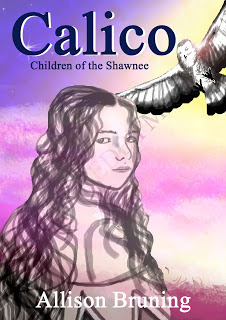 Calico: http://www.amazon.com/Calico-Children-Shawnee-ebook/dp/B007Z8V982
Calico: http://www.amazon.com/Calico-Children-Shawnee-ebook/dp/B007Z8V982
When I picked up the novel Calico by Allison Bruning, I was not sure what to think. With the mention of historical figures such as Chief Pontiac and Daniel Boone, I thought I was on a somber walk through American history as so many books of this caliber often does. I was sorely mistaken.
This novel weaves well-researched history into an exciting frontier story. Coupled with the fact that it dabbles into the realm of American Indian witchcraft and lore, that takes the reader into a dark world often overlooked in books written on the American Indian and the early frontier. Bruning’s knowledge of American Indian History is well researched.
In an uncivilized wilderness, Calico must cope with the loss of her family. Adopted by the Shawnee young Calico is confused and lost. Young Calico must forget her white-man past and live by the law of the Shawnee. In a world where the man is the master and the woman a subservient, Calico come of age.
In a sinister plan where the once trusted white man becomes pitted against the Indian in a web of deceit and lies; lies of the white man or lies of the Indian? This is the confusion Calico must face and a truth she must seek an answer.
If you like early American History, you will love CALICO. If you like, dark magic you are in for a treat. Bruning brings these aspects together like a well-mixed margarita! The first in a series leaves you thirsting for more. I give Calico 5 stars.
Review by
B.E. Schäfer

 Calico: http://www.amazon.com/Calico-Children-Shawnee-ebook/dp/B007Z8V982
Calico: http://www.amazon.com/Calico-Children-Shawnee-ebook/dp/B007Z8V982When I picked up the novel Calico by Allison Bruning, I was not sure what to think. With the mention of historical figures such as Chief Pontiac and Daniel Boone, I thought I was on a somber walk through American history as so many books of this caliber often does. I was sorely mistaken.
This novel weaves well-researched history into an exciting frontier story. Coupled with the fact that it dabbles into the realm of American Indian witchcraft and lore, that takes the reader into a dark world often overlooked in books written on the American Indian and the early frontier. Bruning’s knowledge of American Indian History is well researched.
In an uncivilized wilderness, Calico must cope with the loss of her family. Adopted by the Shawnee young Calico is confused and lost. Young Calico must forget her white-man past and live by the law of the Shawnee. In a world where the man is the master and the woman a subservient, Calico come of age.
In a sinister plan where the once trusted white man becomes pitted against the Indian in a web of deceit and lies; lies of the white man or lies of the Indian? This is the confusion Calico must face and a truth she must seek an answer.
If you like early American History, you will love CALICO. If you like, dark magic you are in for a treat. Bruning brings these aspects together like a well-mixed margarita! The first in a series leaves you thirsting for more. I give Calico 5 stars.
Review by
B.E. Schäfer
Published on May 03, 2012 10:49
March 23, 2012
US Navy Line Crossing Ceremony
The United States Navy Line Crossing Ceremony Since the American Revolution, our military has served toprotect this great country of ours in thirteen wars including our present IraqWar. Today I am humbly reminded of my father. Roland Irving Bruning father entered theUnited States Navy on November 30, 1942 in New York. During his seventeen yearlong Navy career he served in World War II in the Atlantic Fleet and in theKorean War and acquired many ribbons and decorations. These include the Asiatic– Pacific Ribbon (4 stars), Philippine Liberations Ribbon (2 stars, EuropeanAfrican Middle Eastern Area Ribbon (1 star), Good Conduct Medal, American AreaCampaign Ribbon and the World War II Victory Medal. Of all these decorations myfather prided himself upon his Realm of the Arctic Circle and Realm of theGolden Dragon Certificates.

Nogreater Naval tradition is there worldwide than a line crossing ceremony.According to Navel tradition, a pollywog is a sailor who has never crossed theequator line. On February 18, 1944 my father became a golden shellback (thosewho have crossed the Equator on the International Date Line) through a linecrossing ceremony. Afterwards he received his Domain of the Golden Dragoncertificate. Considered a rite of passage that tested upon the sailors abilityto withstand a long ocean journey, many WWII sailors looked forward to theirline ceremony. The day long began as a shellback dressed as King Neptune callsforth the pollywogs. The ceremony theking of the sea interrogates the pollywogs through many embarrassing obstaclessuch as being locked in a salt-water coffin, hair chopping, digging throughrotting garbage, locked in the stocks while shellbacks throw mushy fruit atthem, and other degrading behavior. After each event through the series of obstacles, the pollywog mustdeclare their allegiance to King Neptune. All of the obstacles are meant toentertain the shellbacks while degrade the pollywog. The brutality of theobstacles a pollywog had to endure depends upon the era in which the sailorlived. Up into the 1980's; beatings and severe brutality were so common in theceremony many sailors found themselves in sickbay soon afterwards. Some sailorslost their lives. Even visitingdignitaries were not excluded from the line crossing ceremony. In November1936, President Franklin Roosevelt endured the same harsh treatments when USSIndianapolis crossed the Equator while he was on board.
After apollywog becomes a shellback, the sailor receives a certificate. There areseveral types of line crossing Naval Fraternities. My father had the Order of the Blue Nose andOrder of the Golden Dragon. The Navy recognizes:
The Order of the Blue Nose forsailors who have crossed the Arctic Circle.
The Order of the Red Nose forsailors who have crossed the Antarctic Circle.
The Order of the Golden Dragonfor sailors who have crossed the International Date Line.
The Order of the Ditch forsailors who have passed through the Panama Canal.
The Order of the Rock for sailorswho have transited the Strait of Gibraltar.
The Safari to Suez for sailorswho have passed through the Suez Canal.
The Golden Shellback for sailorswho have crossed the point where the Equator crosses the International DateLine.
The Emerald Shellback or RoyalDiamond Shellback for sailors who cross at 0 degrees off the coast of WestAfrica (where the Equator crosses the Prime Meridian)
The Realm of the Czars forsailors who crossed into the Black Sea.
The Order of Magellan for sailorswho circumnavigated the earth.
The Order of the Lakes forsailors who have sailed on all five Great Lakes.

Nogreater Naval tradition is there worldwide than a line crossing ceremony.According to Navel tradition, a pollywog is a sailor who has never crossed theequator line. On February 18, 1944 my father became a golden shellback (thosewho have crossed the Equator on the International Date Line) through a linecrossing ceremony. Afterwards he received his Domain of the Golden Dragoncertificate. Considered a rite of passage that tested upon the sailors abilityto withstand a long ocean journey, many WWII sailors looked forward to theirline ceremony. The day long began as a shellback dressed as King Neptune callsforth the pollywogs. The ceremony theking of the sea interrogates the pollywogs through many embarrassing obstaclessuch as being locked in a salt-water coffin, hair chopping, digging throughrotting garbage, locked in the stocks while shellbacks throw mushy fruit atthem, and other degrading behavior. After each event through the series of obstacles, the pollywog mustdeclare their allegiance to King Neptune. All of the obstacles are meant toentertain the shellbacks while degrade the pollywog. The brutality of theobstacles a pollywog had to endure depends upon the era in which the sailorlived. Up into the 1980's; beatings and severe brutality were so common in theceremony many sailors found themselves in sickbay soon afterwards. Some sailorslost their lives. Even visitingdignitaries were not excluded from the line crossing ceremony. In November1936, President Franklin Roosevelt endured the same harsh treatments when USSIndianapolis crossed the Equator while he was on board.
After apollywog becomes a shellback, the sailor receives a certificate. There areseveral types of line crossing Naval Fraternities. My father had the Order of the Blue Nose andOrder of the Golden Dragon. The Navy recognizes:
The Order of the Blue Nose forsailors who have crossed the Arctic Circle.
The Order of the Red Nose forsailors who have crossed the Antarctic Circle.
The Order of the Golden Dragonfor sailors who have crossed the International Date Line.
The Order of the Ditch forsailors who have passed through the Panama Canal.
The Order of the Rock for sailorswho have transited the Strait of Gibraltar.
The Safari to Suez for sailorswho have passed through the Suez Canal.
The Golden Shellback for sailorswho have crossed the point where the Equator crosses the International DateLine.
The Emerald Shellback or RoyalDiamond Shellback for sailors who cross at 0 degrees off the coast of WestAfrica (where the Equator crosses the Prime Meridian)
The Realm of the Czars forsailors who crossed into the Black Sea.
The Order of Magellan for sailorswho circumnavigated the earth.
The Order of the Lakes forsailors who have sailed on all five Great Lakes.
Published on March 23, 2012 05:21
March 13, 2012
Farmer's Markets Preserve Local Heritage
Farmer's Markets Preserve Local Heritage
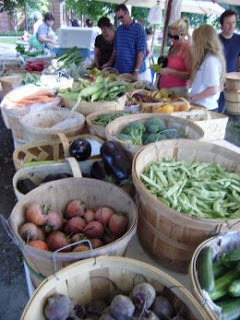 We live in a world of consumerism, processed foods and diets full of sugars and fats. While our fast past society filled with overindulgence of material wealth and stressors that deteriorate our bodies. It is our diet that has lead to the growth of obesity, eating disorders and diabetes. Our diets have even threatened the lives of our children. Their sedentary lifestyle and diet had lead to juvenile diabetes and obesity. The obesity had granted our children health problems that have generally not been seen in children but adults. With our nation's health and children at risk some families have turned to a change of diet and more active lifestyles.
We live in a world of consumerism, processed foods and diets full of sugars and fats. While our fast past society filled with overindulgence of material wealth and stressors that deteriorate our bodies. It is our diet that has lead to the growth of obesity, eating disorders and diabetes. Our diets have even threatened the lives of our children. Their sedentary lifestyle and diet had lead to juvenile diabetes and obesity. The obesity had granted our children health problems that have generally not been seen in children but adults. With our nation's health and children at risk some families have turned to a change of diet and more active lifestyles.
A well-balanced diet of organic foods and healthier choices is hard in the United States to achieve. Our televisions bombard our children with advertisements for candy, soda, and fast-food. Families with low income find it economically affordable to spend money of processed and fast foods. The market is saturated with subliminal messages promoting an unhealthy diet. It is less expensive to buy processed foods than healthy and organic ones. For a fast paced society sometimes it is much easier and cost effective to forgo making meals at home and buy a value meal at your favorite fast food place. Many health conscious Americans have turned away from the supermarkets towards their local farmer's market.
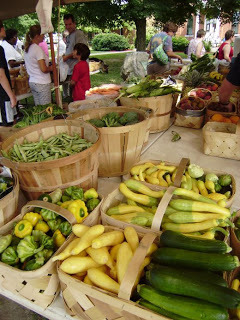 A farmer's market often takes place outdoors. Local farmers generally gather with tables of locally grown and fresh products. Products may include homemade baked goods, jelly's, meats, candies, vegetables, fruits, eggs, cheese, milk and other products made on the farm. The small farmer depends upon the farmer's market to make his products known to the public. By selling directly to the public he or she receives a better price than going through a middle man. The small farmer also plays a role in preserving not only America's agricultural legacy but the natural resources.
A farmer's market often takes place outdoors. Local farmers generally gather with tables of locally grown and fresh products. Products may include homemade baked goods, jelly's, meats, candies, vegetables, fruits, eggs, cheese, milk and other products made on the farm. The small farmer depends upon the farmer's market to make his products known to the public. By selling directly to the public he or she receives a better price than going through a middle man. The small farmer also plays a role in preserving not only America's agricultural legacy but the natural resources.
In today's agricultural society, major corporations such as Chiquita and Dole have saturated the market so much they have inevitable begun the decimation of small family owned and operated farms. They buy large acres of land then reuse them every year instead of rotating their crops. Overtime the overuse of the natural resources depletes the soil and the corporations must add chemicals to sustain their crops. They also use chemicals to repel pests. The corporate farmers depend upon the supermarkets and advertising to promote their products. Most of these products have been processed to sustain a longer shelf life . This process uses chemicals that are harmful to our bodies. All the products sold at a farmer's market do not contain process.
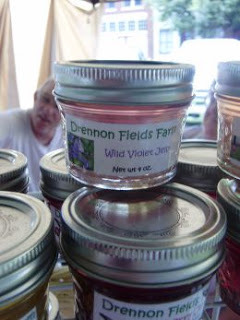 Farmer's markets have developed over time across the entire United States. According to Wikipedia, the number of farm markets across the United States had grown from 1,755 in 1994 to 5,274 in 2009. Farmer's markets may be found in the large metropolis such as New York City down to the small towns such as LaGrange, Kentucky. Food consumption is not the only product available at a Farmer's Market. Artist, musicians, livestock and crafts may be found as well. The duration and frequency of a Farmer's Market depends up on the local environment in which one is established. Some take place during festivals while other are a weekend event during the summer and fall. Travelers should never miss a Farmer's Market since they offer a realistic, localized flavor of the area.
Farmer's markets have developed over time across the entire United States. According to Wikipedia, the number of farm markets across the United States had grown from 1,755 in 1994 to 5,274 in 2009. Farmer's markets may be found in the large metropolis such as New York City down to the small towns such as LaGrange, Kentucky. Food consumption is not the only product available at a Farmer's Market. Artist, musicians, livestock and crafts may be found as well. The duration and frequency of a Farmer's Market depends up on the local environment in which one is established. Some take place during festivals while other are a weekend event during the summer and fall. Travelers should never miss a Farmer's Market since they offer a realistic, localized flavor of the area.

 We live in a world of consumerism, processed foods and diets full of sugars and fats. While our fast past society filled with overindulgence of material wealth and stressors that deteriorate our bodies. It is our diet that has lead to the growth of obesity, eating disorders and diabetes. Our diets have even threatened the lives of our children. Their sedentary lifestyle and diet had lead to juvenile diabetes and obesity. The obesity had granted our children health problems that have generally not been seen in children but adults. With our nation's health and children at risk some families have turned to a change of diet and more active lifestyles.
We live in a world of consumerism, processed foods and diets full of sugars and fats. While our fast past society filled with overindulgence of material wealth and stressors that deteriorate our bodies. It is our diet that has lead to the growth of obesity, eating disorders and diabetes. Our diets have even threatened the lives of our children. Their sedentary lifestyle and diet had lead to juvenile diabetes and obesity. The obesity had granted our children health problems that have generally not been seen in children but adults. With our nation's health and children at risk some families have turned to a change of diet and more active lifestyles. A well-balanced diet of organic foods and healthier choices is hard in the United States to achieve. Our televisions bombard our children with advertisements for candy, soda, and fast-food. Families with low income find it economically affordable to spend money of processed and fast foods. The market is saturated with subliminal messages promoting an unhealthy diet. It is less expensive to buy processed foods than healthy and organic ones. For a fast paced society sometimes it is much easier and cost effective to forgo making meals at home and buy a value meal at your favorite fast food place. Many health conscious Americans have turned away from the supermarkets towards their local farmer's market.
 A farmer's market often takes place outdoors. Local farmers generally gather with tables of locally grown and fresh products. Products may include homemade baked goods, jelly's, meats, candies, vegetables, fruits, eggs, cheese, milk and other products made on the farm. The small farmer depends upon the farmer's market to make his products known to the public. By selling directly to the public he or she receives a better price than going through a middle man. The small farmer also plays a role in preserving not only America's agricultural legacy but the natural resources.
A farmer's market often takes place outdoors. Local farmers generally gather with tables of locally grown and fresh products. Products may include homemade baked goods, jelly's, meats, candies, vegetables, fruits, eggs, cheese, milk and other products made on the farm. The small farmer depends upon the farmer's market to make his products known to the public. By selling directly to the public he or she receives a better price than going through a middle man. The small farmer also plays a role in preserving not only America's agricultural legacy but the natural resources. In today's agricultural society, major corporations such as Chiquita and Dole have saturated the market so much they have inevitable begun the decimation of small family owned and operated farms. They buy large acres of land then reuse them every year instead of rotating their crops. Overtime the overuse of the natural resources depletes the soil and the corporations must add chemicals to sustain their crops. They also use chemicals to repel pests. The corporate farmers depend upon the supermarkets and advertising to promote their products. Most of these products have been processed to sustain a longer shelf life . This process uses chemicals that are harmful to our bodies. All the products sold at a farmer's market do not contain process.
 Farmer's markets have developed over time across the entire United States. According to Wikipedia, the number of farm markets across the United States had grown from 1,755 in 1994 to 5,274 in 2009. Farmer's markets may be found in the large metropolis such as New York City down to the small towns such as LaGrange, Kentucky. Food consumption is not the only product available at a Farmer's Market. Artist, musicians, livestock and crafts may be found as well. The duration and frequency of a Farmer's Market depends up on the local environment in which one is established. Some take place during festivals while other are a weekend event during the summer and fall. Travelers should never miss a Farmer's Market since they offer a realistic, localized flavor of the area.
Farmer's markets have developed over time across the entire United States. According to Wikipedia, the number of farm markets across the United States had grown from 1,755 in 1994 to 5,274 in 2009. Farmer's markets may be found in the large metropolis such as New York City down to the small towns such as LaGrange, Kentucky. Food consumption is not the only product available at a Farmer's Market. Artist, musicians, livestock and crafts may be found as well. The duration and frequency of a Farmer's Market depends up on the local environment in which one is established. Some take place during festivals while other are a weekend event during the summer and fall. Travelers should never miss a Farmer's Market since they offer a realistic, localized flavor of the area.
Published on March 13, 2012 17:48
March 12, 2012
A Kentucky Hidden Gem - Rabbit Hash, Kentucky
Rabbit Hash, Kentucky
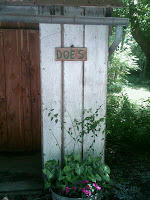
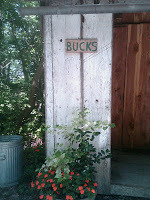 Deep within the northern reaches of Boone County lies the hidden Kentucky gem of Rabbit Hash, Kentucky. One of the few early 19th century Ohio River towns left in America, Rabbit Hash maintains its eclectic charms. The United States Post Office built on January 3, 1879 originally deemed the village "Carleton, Kentucky. Yet residents soon found many travelers mistaken the village for Carrolton, Ky. Several stories abound concerning how Rabbit Hash received its name. Robert Rennerick, author of "Kentucky Place Names" retells an explanation A.M. Yearley wrote in his 1960 "History of Boone County". He writes of two salt or fur traders:
Deep within the northern reaches of Boone County lies the hidden Kentucky gem of Rabbit Hash, Kentucky. One of the few early 19th century Ohio River towns left in America, Rabbit Hash maintains its eclectic charms. The United States Post Office built on January 3, 1879 originally deemed the village "Carleton, Kentucky. Yet residents soon found many travelers mistaken the village for Carrolton, Ky. Several stories abound concerning how Rabbit Hash received its name. Robert Rennerick, author of "Kentucky Place Names" retells an explanation A.M. Yearley wrote in his 1960 "History of Boone County". He writes of two salt or fur traders:
"During the flood of 1816, two travelers were looking for something to eat. When they asked about the availability of food they were told that because the flood drove so many rabbits into the hills, there were plenty of rabbits available to make hash."
Another version, taken place thirty two years before the post office changed the name of the town stipulates during the Christmas Day flood of 1847, due to the two feet deep snow, combined with extreme cold residents had to take shelter with their neighbors. With no food to eat and hunger rampant they began to speak of the animals they would have hunted for Christmas Dinner. They spoke of geese, hens, and other animals. When asked with Frank would have served he simply replied, "Rabbit Hash."
One local resident told me the town was named after a local flood. The residents were starving. They looked to the Ohio River when they saw several dead rabbits floating on top. They residents had Rabbit Hash thus the name stuck.
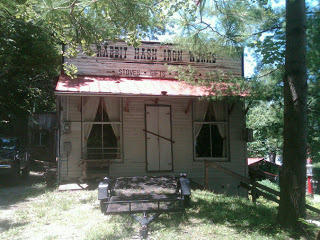 Whatever the reasoning behind the town's name, Rabbit Hash has enjoyed a cooperative relationship with is sister city across river. Built in 1813, Rabbit Hash sits upon the Kentucky shore across the Ohio River from Rising Sun, Indiana. Established in 1814, Rising Sun enjoyed the benefits of transriver commerce. During the riverboat era's Rabbit Hash tried to conduct itself a port yet due to sandbars and shallow water, so shallow you could cross the Ohio River by foot, the town abandoned their hopes. Riverboats made their way through Boone county with a stop at Rising Sun, Indiana. The across river traffic brought several benefits and amenities to Rabbit Hash permanently connecting the two towns.
Whatever the reasoning behind the town's name, Rabbit Hash has enjoyed a cooperative relationship with is sister city across river. Built in 1813, Rabbit Hash sits upon the Kentucky shore across the Ohio River from Rising Sun, Indiana. Established in 1814, Rising Sun enjoyed the benefits of transriver commerce. During the riverboat era's Rabbit Hash tried to conduct itself a port yet due to sandbars and shallow water, so shallow you could cross the Ohio River by foot, the town abandoned their hopes. Riverboats made their way through Boone county with a stop at Rising Sun, Indiana. The across river traffic brought several benefits and amenities to Rabbit Hash permanently connecting the two towns.
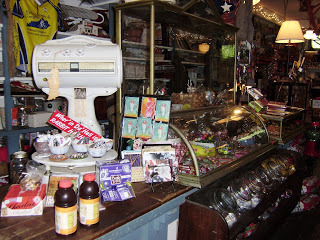 Like most Ohio River front towns, Rabbit Hash has seen its fair share of flooding. Along the exterior wall of the mercantile building flood gauges mark the height of each flood. Standing 6 foot tall, the flood of 1773 and another flood towered over my head. It serves not only a historical reminder to the dangers of building a town so close to the river but a gentle mark of heritage. Although, Rabbit Hash located 506.1 miles below Pittsburg life along the Ohio River can traumatic and peaceful for any resident or visitor.
Like most Ohio River front towns, Rabbit Hash has seen its fair share of flooding. Along the exterior wall of the mercantile building flood gauges mark the height of each flood. Standing 6 foot tall, the flood of 1773 and another flood towered over my head. It serves not only a historical reminder to the dangers of building a town so close to the river but a gentle mark of heritage. Although, Rabbit Hash located 506.1 miles below Pittsburg life along the Ohio River can traumatic and peaceful for any resident or visitor.
Rabbit Hash General Store lies at the center of the historic town. The building surrounding the town contains a wide variety of antiques and oddities any collector would love. Due to the historical society proprietorship and marked National Register District all buildings maintain their 18th century glamour. Although the building contains running water and electricity nothing else is changed. You feel as if you've entered an early 19th century frontier Kentucky town. Built in 1831, the Rabbit Hash General Store hails the oldest building on the 33acres linear rural village. It contains several unique items including soft drinks, teas and food items. The Rabbit Hash General Store has continuously been a working general store since its establishment.


 Deep within the northern reaches of Boone County lies the hidden Kentucky gem of Rabbit Hash, Kentucky. One of the few early 19th century Ohio River towns left in America, Rabbit Hash maintains its eclectic charms. The United States Post Office built on January 3, 1879 originally deemed the village "Carleton, Kentucky. Yet residents soon found many travelers mistaken the village for Carrolton, Ky. Several stories abound concerning how Rabbit Hash received its name. Robert Rennerick, author of "Kentucky Place Names" retells an explanation A.M. Yearley wrote in his 1960 "History of Boone County". He writes of two salt or fur traders:
Deep within the northern reaches of Boone County lies the hidden Kentucky gem of Rabbit Hash, Kentucky. One of the few early 19th century Ohio River towns left in America, Rabbit Hash maintains its eclectic charms. The United States Post Office built on January 3, 1879 originally deemed the village "Carleton, Kentucky. Yet residents soon found many travelers mistaken the village for Carrolton, Ky. Several stories abound concerning how Rabbit Hash received its name. Robert Rennerick, author of "Kentucky Place Names" retells an explanation A.M. Yearley wrote in his 1960 "History of Boone County". He writes of two salt or fur traders:"During the flood of 1816, two travelers were looking for something to eat. When they asked about the availability of food they were told that because the flood drove so many rabbits into the hills, there were plenty of rabbits available to make hash."
Another version, taken place thirty two years before the post office changed the name of the town stipulates during the Christmas Day flood of 1847, due to the two feet deep snow, combined with extreme cold residents had to take shelter with their neighbors. With no food to eat and hunger rampant they began to speak of the animals they would have hunted for Christmas Dinner. They spoke of geese, hens, and other animals. When asked with Frank would have served he simply replied, "Rabbit Hash."
One local resident told me the town was named after a local flood. The residents were starving. They looked to the Ohio River when they saw several dead rabbits floating on top. They residents had Rabbit Hash thus the name stuck.
 Whatever the reasoning behind the town's name, Rabbit Hash has enjoyed a cooperative relationship with is sister city across river. Built in 1813, Rabbit Hash sits upon the Kentucky shore across the Ohio River from Rising Sun, Indiana. Established in 1814, Rising Sun enjoyed the benefits of transriver commerce. During the riverboat era's Rabbit Hash tried to conduct itself a port yet due to sandbars and shallow water, so shallow you could cross the Ohio River by foot, the town abandoned their hopes. Riverboats made their way through Boone county with a stop at Rising Sun, Indiana. The across river traffic brought several benefits and amenities to Rabbit Hash permanently connecting the two towns.
Whatever the reasoning behind the town's name, Rabbit Hash has enjoyed a cooperative relationship with is sister city across river. Built in 1813, Rabbit Hash sits upon the Kentucky shore across the Ohio River from Rising Sun, Indiana. Established in 1814, Rising Sun enjoyed the benefits of transriver commerce. During the riverboat era's Rabbit Hash tried to conduct itself a port yet due to sandbars and shallow water, so shallow you could cross the Ohio River by foot, the town abandoned their hopes. Riverboats made their way through Boone county with a stop at Rising Sun, Indiana. The across river traffic brought several benefits and amenities to Rabbit Hash permanently connecting the two towns.  Like most Ohio River front towns, Rabbit Hash has seen its fair share of flooding. Along the exterior wall of the mercantile building flood gauges mark the height of each flood. Standing 6 foot tall, the flood of 1773 and another flood towered over my head. It serves not only a historical reminder to the dangers of building a town so close to the river but a gentle mark of heritage. Although, Rabbit Hash located 506.1 miles below Pittsburg life along the Ohio River can traumatic and peaceful for any resident or visitor.
Like most Ohio River front towns, Rabbit Hash has seen its fair share of flooding. Along the exterior wall of the mercantile building flood gauges mark the height of each flood. Standing 6 foot tall, the flood of 1773 and another flood towered over my head. It serves not only a historical reminder to the dangers of building a town so close to the river but a gentle mark of heritage. Although, Rabbit Hash located 506.1 miles below Pittsburg life along the Ohio River can traumatic and peaceful for any resident or visitor. Rabbit Hash General Store lies at the center of the historic town. The building surrounding the town contains a wide variety of antiques and oddities any collector would love. Due to the historical society proprietorship and marked National Register District all buildings maintain their 18th century glamour. Although the building contains running water and electricity nothing else is changed. You feel as if you've entered an early 19th century frontier Kentucky town. Built in 1831, the Rabbit Hash General Store hails the oldest building on the 33acres linear rural village. It contains several unique items including soft drinks, teas and food items. The Rabbit Hash General Store has continuously been a working general store since its establishment.
Published on March 12, 2012 06:28
March 11, 2012
Six Lines on Sunday 3/11/2012
Calico By: Allison Bruning
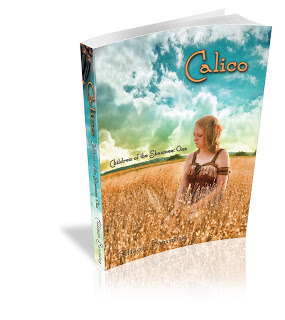 http://amzn.to/tEO4d0 The demon knelt before Alexander. Her floral scent drew his attention to her every movement. She was irresistible. The harder he tried, the more her body called to him. She placed her cold hand along his right cheek and moved her lips close to his. Fear and desire consumed him. "No man has ever denied me," she whispered in his ear. Alexander tensed as she traced her lips along his cheek. "Poison me and be done with it, demon," he snarled.
http://amzn.to/tEO4d0 The demon knelt before Alexander. Her floral scent drew his attention to her every movement. She was irresistible. The harder he tried, the more her body called to him. She placed her cold hand along his right cheek and moved her lips close to his. Fear and desire consumed him. "No man has ever denied me," she whispered in his ear. Alexander tensed as she traced her lips along his cheek. "Poison me and be done with it, demon," he snarled.
Published on March 11, 2012 06:18
March 7, 2012
Marion, Ohio's Own, President Warren G. Harding
Marion, Ohio's Own: President Warren G. Harding
My mother's family came to this county before the United States existed. My ancestors fought in the Revolutionary War. After the war ended we travelled into the Ohio Wilderness where my family settled into the Ohio Territory. We were there when Ohio became a state. We were there to help form Marion County, Ohio and we were there when Marion, Ohio became a town. My family has seen Marion, Ohio grown from a small town into the small city it is today. We have seen Presidents come and go from President Washington to President Obama but none have lived closer them than President Warren G. Harding.
 Ohio's Eight United States PresidentsThe state of Ohio is sometimes known as the "Mother of Presidents". Eight United States presidents: William Henry Harrison, Ulysses Simpson Grant, Rutherford Birchard Hayes, James Abram Garfield, Benjamin Harrison, William McKinley, William Howard Taft and Warren Gamaliel Harding, all came from my home state. Yet only one can boast as a native of Marion, Ohio, Warren G. Harding.
Ohio's Eight United States PresidentsThe state of Ohio is sometimes known as the "Mother of Presidents". Eight United States presidents: William Henry Harrison, Ulysses Simpson Grant, Rutherford Birchard Hayes, James Abram Garfield, Benjamin Harrison, William McKinley, William Howard Taft and Warren Gamaliel Harding, all came from my home state. Yet only one can boast as a native of Marion, Ohio, Warren G. Harding.
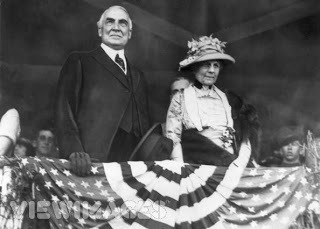 Warren G Harding and his wife, FlorenceWarren G. Harding was born the eldest of eight children, on November 2, 1865 in Marion, Ohio to Dr. George Tyron Harding, Sr. and Phoebe Elizabeth (Dickerson) Harding. At the age of 10, Warren began to work with his father on the small family owned and operated local newspaper, The Argus. There he fell in love with the newspaper trade. Harding attended the Ohio Central College in Iberia, Ohio where he studied printing and newspaper trade. In 1882, at 16 years of age, he graduated with a Bachelor of Science with as an accomplished public speaker. Four years later, he bought the Marion Daily Star, one of three newspapers in the city for $300. The strongest read paper at the time was The Marion Independent. Harding worked hard to unset the paper and move his own into its position. The effort took its toll on Harding. In 1889, he suffered from exhausted and nervous fatigue but his paper was one of the most popular newspapers of Marion County. After spending several weeks at the Battle Creek Sanitarium, Harding returned to his beloved paper. In 1891, Harding married Florence Kling DeWolfe, the daughter of his newspaper nemesis, Amos Hall King. By 1896, the Marion Daily Star, became so popular his rival newspapers had gone out of business. It became so strong, Harding and his wife were able to travel around the country, which exposed Harding at political gatherings.
Warren G Harding and his wife, FlorenceWarren G. Harding was born the eldest of eight children, on November 2, 1865 in Marion, Ohio to Dr. George Tyron Harding, Sr. and Phoebe Elizabeth (Dickerson) Harding. At the age of 10, Warren began to work with his father on the small family owned and operated local newspaper, The Argus. There he fell in love with the newspaper trade. Harding attended the Ohio Central College in Iberia, Ohio where he studied printing and newspaper trade. In 1882, at 16 years of age, he graduated with a Bachelor of Science with as an accomplished public speaker. Four years later, he bought the Marion Daily Star, one of three newspapers in the city for $300. The strongest read paper at the time was The Marion Independent. Harding worked hard to unset the paper and move his own into its position. The effort took its toll on Harding. In 1889, he suffered from exhausted and nervous fatigue but his paper was one of the most popular newspapers of Marion County. After spending several weeks at the Battle Creek Sanitarium, Harding returned to his beloved paper. In 1891, Harding married Florence Kling DeWolfe, the daughter of his newspaper nemesis, Amos Hall King. By 1896, the Marion Daily Star, became so popular his rival newspapers had gone out of business. It became so strong, Harding and his wife were able to travel around the country, which exposed Harding at political gatherings.
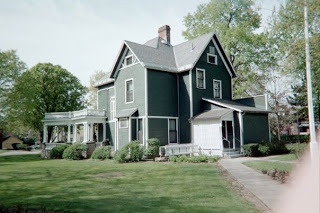 President Harding's Home
President Harding's Home
The following years, Harding moved out of the newspaper business and into politics. In 1889, he served a term on Ohio State Senate for the 13th Senatorial District. He served two terms in the office then was awarded the Lt. Governorship of Ohio from 1904 to 1906. In 1910 he ran for Ohio State Governor but lost the race to the incumbent Judson Harmon. Harding served as U.S. Senator for Ohio under the term of Woodrow Wilson. During his presidential campaign of 1920, Harding held many speeches from railcars and his front porch. Many came from all over to hear him. He won the election and served as U.S. President from 1921-1923. President Warren G. Harding died in mid conversation with his wife at 7:35pm on August 2, 1923 from a heart attack. President Harding was buried in Marion, Ohio on August 10, 1923. His wife died on November 21, 1924. On December 20, 1927 both the President and his wife's bodies were reburied at the new Harding Memorial. You can visit both their graves today and their house.
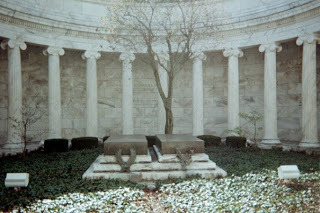 Inside the Harding Memorial.
Inside the Harding Memorial.
President Harding and his wife's graves.
My mother's family came to this county before the United States existed. My ancestors fought in the Revolutionary War. After the war ended we travelled into the Ohio Wilderness where my family settled into the Ohio Territory. We were there when Ohio became a state. We were there to help form Marion County, Ohio and we were there when Marion, Ohio became a town. My family has seen Marion, Ohio grown from a small town into the small city it is today. We have seen Presidents come and go from President Washington to President Obama but none have lived closer them than President Warren G. Harding.
 Ohio's Eight United States PresidentsThe state of Ohio is sometimes known as the "Mother of Presidents". Eight United States presidents: William Henry Harrison, Ulysses Simpson Grant, Rutherford Birchard Hayes, James Abram Garfield, Benjamin Harrison, William McKinley, William Howard Taft and Warren Gamaliel Harding, all came from my home state. Yet only one can boast as a native of Marion, Ohio, Warren G. Harding.
Ohio's Eight United States PresidentsThe state of Ohio is sometimes known as the "Mother of Presidents". Eight United States presidents: William Henry Harrison, Ulysses Simpson Grant, Rutherford Birchard Hayes, James Abram Garfield, Benjamin Harrison, William McKinley, William Howard Taft and Warren Gamaliel Harding, all came from my home state. Yet only one can boast as a native of Marion, Ohio, Warren G. Harding.  Warren G Harding and his wife, FlorenceWarren G. Harding was born the eldest of eight children, on November 2, 1865 in Marion, Ohio to Dr. George Tyron Harding, Sr. and Phoebe Elizabeth (Dickerson) Harding. At the age of 10, Warren began to work with his father on the small family owned and operated local newspaper, The Argus. There he fell in love with the newspaper trade. Harding attended the Ohio Central College in Iberia, Ohio where he studied printing and newspaper trade. In 1882, at 16 years of age, he graduated with a Bachelor of Science with as an accomplished public speaker. Four years later, he bought the Marion Daily Star, one of three newspapers in the city for $300. The strongest read paper at the time was The Marion Independent. Harding worked hard to unset the paper and move his own into its position. The effort took its toll on Harding. In 1889, he suffered from exhausted and nervous fatigue but his paper was one of the most popular newspapers of Marion County. After spending several weeks at the Battle Creek Sanitarium, Harding returned to his beloved paper. In 1891, Harding married Florence Kling DeWolfe, the daughter of his newspaper nemesis, Amos Hall King. By 1896, the Marion Daily Star, became so popular his rival newspapers had gone out of business. It became so strong, Harding and his wife were able to travel around the country, which exposed Harding at political gatherings.
Warren G Harding and his wife, FlorenceWarren G. Harding was born the eldest of eight children, on November 2, 1865 in Marion, Ohio to Dr. George Tyron Harding, Sr. and Phoebe Elizabeth (Dickerson) Harding. At the age of 10, Warren began to work with his father on the small family owned and operated local newspaper, The Argus. There he fell in love with the newspaper trade. Harding attended the Ohio Central College in Iberia, Ohio where he studied printing and newspaper trade. In 1882, at 16 years of age, he graduated with a Bachelor of Science with as an accomplished public speaker. Four years later, he bought the Marion Daily Star, one of three newspapers in the city for $300. The strongest read paper at the time was The Marion Independent. Harding worked hard to unset the paper and move his own into its position. The effort took its toll on Harding. In 1889, he suffered from exhausted and nervous fatigue but his paper was one of the most popular newspapers of Marion County. After spending several weeks at the Battle Creek Sanitarium, Harding returned to his beloved paper. In 1891, Harding married Florence Kling DeWolfe, the daughter of his newspaper nemesis, Amos Hall King. By 1896, the Marion Daily Star, became so popular his rival newspapers had gone out of business. It became so strong, Harding and his wife were able to travel around the country, which exposed Harding at political gatherings.  President Harding's Home
President Harding's HomeThe following years, Harding moved out of the newspaper business and into politics. In 1889, he served a term on Ohio State Senate for the 13th Senatorial District. He served two terms in the office then was awarded the Lt. Governorship of Ohio from 1904 to 1906. In 1910 he ran for Ohio State Governor but lost the race to the incumbent Judson Harmon. Harding served as U.S. Senator for Ohio under the term of Woodrow Wilson. During his presidential campaign of 1920, Harding held many speeches from railcars and his front porch. Many came from all over to hear him. He won the election and served as U.S. President from 1921-1923. President Warren G. Harding died in mid conversation with his wife at 7:35pm on August 2, 1923 from a heart attack. President Harding was buried in Marion, Ohio on August 10, 1923. His wife died on November 21, 1924. On December 20, 1927 both the President and his wife's bodies were reburied at the new Harding Memorial. You can visit both their graves today and their house.
 Inside the Harding Memorial.
Inside the Harding Memorial. President Harding and his wife's graves.
Published on March 07, 2012 06:44
February 27, 2012
The Candyman - Bruning Brothers Confectionary
The Candyman
Bruning Brothers Confectionary
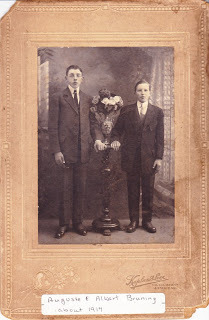 A German immigrant, my grandfather, August Bruning began his American business dream with his younger brother Albert during the early part of the 20th century along the east coast. Bruning Brother Confectionary ran for many years between New Jersey and New York only to turn into Bruning Ice Cream mid century.
A German immigrant, my grandfather, August Bruning began his American business dream with his younger brother Albert during the early part of the 20th century along the east coast. Bruning Brother Confectionary ran for many years between New Jersey and New York only to turn into Bruning Ice Cream mid century.
During the beginning of the twentieth century the local confectionary was the place to be for any youngster. Webster's dictionary defines a confection as any sweet food such as candy or pastry. A confectioner was the person who crafted the treat and his shop contained the most delicious treats he or she made from sugar. Today confectionary stores are hard to find in United States. Some local and regional stores exist within small towns yet commercialization has threatened these small business owners through supply and demand. Most of the modern day confections can be found anywhere from general stores to gas stations.
In the United States we call any confection, candy. Yet travel around the world and you may encounter different names. For example, in Australia and New Zealand candy is often referred to as "lollies". Britain, Ireland and other commonwealth states use the term "sweet." Confections come in a wide variety of categories. These include yet not limited to: toffee, fudge, hard sweets and liquorices. While they taste good, moderation is best. Constant intake of any sweet may lead to type 2 diabetes or tooth decay.
In my grandfather's days the supermarkets and convenience stores didn't exist for large candy makers, such as Hersey's, to market their products. Youngsters drove towards their local confectionary store to satisfy their sweet tooth. A trip into one of these stores was wonderland for any child. All types of candy displayed everywhere for the eye to see in a wide variety of color and imagination. I'm often reminded of the "Candy Man" from the 1971 movie "Willy Wonka and the Chocolate Factory." (my father, Roland Irving Bruning, loved that movie. So do I.)
Throughout the 19th century all candy had been sold to the consumer through loose small piece that were weighed, bought then bagged. In the early 20th century, the time of Bruning Brothers Confections, commercial confectionary stores grew rapidly across the United States. Local confectionaries began to experiment with their own localized candy bar creations. Today some of these regional candy bars have become household names, such as Hersey and Mars.
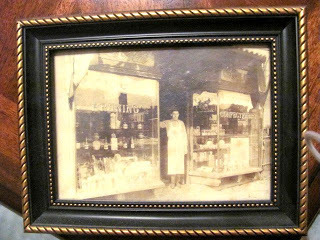 My grandfather, August Bruning, outside his candy store.I am proud of my grandfather who became a piece of American history as one of these confectionary owners. It's a shame the small town confectionaries have become a place of our past and not of our future as commercialization threatens our small town businesses. Next time you have a chance to visit a local confectionary store remember men such as my grandfather who dared to dream of chocolate, sugar, fun and children. The candyman.
My grandfather, August Bruning, outside his candy store.I am proud of my grandfather who became a piece of American history as one of these confectionary owners. It's a shame the small town confectionaries have become a place of our past and not of our future as commercialization threatens our small town businesses. Next time you have a chance to visit a local confectionary store remember men such as my grandfather who dared to dream of chocolate, sugar, fun and children. The candyman.

 A German immigrant, my grandfather, August Bruning began his American business dream with his younger brother Albert during the early part of the 20th century along the east coast. Bruning Brother Confectionary ran for many years between New Jersey and New York only to turn into Bruning Ice Cream mid century.
A German immigrant, my grandfather, August Bruning began his American business dream with his younger brother Albert during the early part of the 20th century along the east coast. Bruning Brother Confectionary ran for many years between New Jersey and New York only to turn into Bruning Ice Cream mid century. During the beginning of the twentieth century the local confectionary was the place to be for any youngster. Webster's dictionary defines a confection as any sweet food such as candy or pastry. A confectioner was the person who crafted the treat and his shop contained the most delicious treats he or she made from sugar. Today confectionary stores are hard to find in United States. Some local and regional stores exist within small towns yet commercialization has threatened these small business owners through supply and demand. Most of the modern day confections can be found anywhere from general stores to gas stations.
In the United States we call any confection, candy. Yet travel around the world and you may encounter different names. For example, in Australia and New Zealand candy is often referred to as "lollies". Britain, Ireland and other commonwealth states use the term "sweet." Confections come in a wide variety of categories. These include yet not limited to: toffee, fudge, hard sweets and liquorices. While they taste good, moderation is best. Constant intake of any sweet may lead to type 2 diabetes or tooth decay.
In my grandfather's days the supermarkets and convenience stores didn't exist for large candy makers, such as Hersey's, to market their products. Youngsters drove towards their local confectionary store to satisfy their sweet tooth. A trip into one of these stores was wonderland for any child. All types of candy displayed everywhere for the eye to see in a wide variety of color and imagination. I'm often reminded of the "Candy Man" from the 1971 movie "Willy Wonka and the Chocolate Factory." (my father, Roland Irving Bruning, loved that movie. So do I.)
Throughout the 19th century all candy had been sold to the consumer through loose small piece that were weighed, bought then bagged. In the early 20th century, the time of Bruning Brothers Confections, commercial confectionary stores grew rapidly across the United States. Local confectionaries began to experiment with their own localized candy bar creations. Today some of these regional candy bars have become household names, such as Hersey and Mars.
 My grandfather, August Bruning, outside his candy store.I am proud of my grandfather who became a piece of American history as one of these confectionary owners. It's a shame the small town confectionaries have become a place of our past and not of our future as commercialization threatens our small town businesses. Next time you have a chance to visit a local confectionary store remember men such as my grandfather who dared to dream of chocolate, sugar, fun and children. The candyman.
My grandfather, August Bruning, outside his candy store.I am proud of my grandfather who became a piece of American history as one of these confectionary owners. It's a shame the small town confectionaries have become a place of our past and not of our future as commercialization threatens our small town businesses. Next time you have a chance to visit a local confectionary store remember men such as my grandfather who dared to dream of chocolate, sugar, fun and children. The candyman.
Published on February 27, 2012 08:00
February 25, 2012
The Native Muse
The Native MuseBy: Allison Bruning
She watched earnestly with wisdom
This Native American woman on my desktop wallpaper
Guarding my writings and photography
She beckons the writer within me
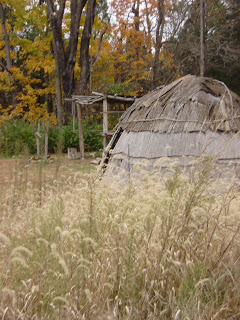 I heed her call
I heed her call
What wonders will she take me to today?
Shall we walk the ride the plains with the Blackfeet or Sioux?
Or dance with the Shawnee around the great campfire?
Follow the Navajo sheepherders?
Or fish with the great Pacific tribes?
Words spread across my Microsoft Word
Images of lands far away
People, creatures and ideas foreign to my
fast paced, computerized world
Yet familiar to her
A moment becomes a day
Lost in time, I forget the keys under my fingers
Paragraphs become reality
I lose myself in the plot
Suspense, history, romance and danger await me
Her world transforms my thoughts
No longer am I the writer
I actively take part in her story
Her ideas and speech create emotions I'd never felt before
The land, the people, and the ideas they're so real
Her story becomes my own
I want to press on
I have to know more
She guides me through her story only to release me into my own reality
I lean back from my computer
Released from my creative endeavor
My Native American muse sits quietly upon my desktop wallpaper
With a stare towards me
Her secret journey my own
Given to those who dare to read
She watched earnestly with wisdom
This Native American woman on my desktop wallpaper
Guarding my writings and photography
She beckons the writer within me
 I heed her call
I heed her callWhat wonders will she take me to today?
Shall we walk the ride the plains with the Blackfeet or Sioux?
Or dance with the Shawnee around the great campfire?
Follow the Navajo sheepherders?
Or fish with the great Pacific tribes?
Words spread across my Microsoft Word
Images of lands far away
People, creatures and ideas foreign to my
fast paced, computerized world
Yet familiar to her
A moment becomes a day
Lost in time, I forget the keys under my fingers
Paragraphs become reality
I lose myself in the plot
Suspense, history, romance and danger await me
Her world transforms my thoughts
No longer am I the writer
I actively take part in her story
Her ideas and speech create emotions I'd never felt before
The land, the people, and the ideas they're so real
Her story becomes my own
I want to press on
I have to know more
She guides me through her story only to release me into my own reality
I lean back from my computer
Released from my creative endeavor
My Native American muse sits quietly upon my desktop wallpaper
With a stare towards me
Her secret journey my own
Given to those who dare to read
Published on February 25, 2012 05:31



